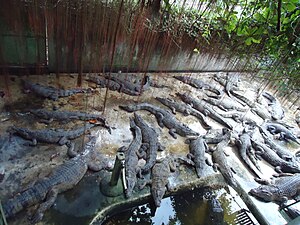
Crocodile farming in the Philippines refers to agricultural industries involving the raising and harvesting of crocodiles for the commercial production of Crocodile meat and crocodile leather.
In the Philippines, crocodile farmers breed and raise two species of Philippine crocodiles: the Philippine saltwater crocodile (Crocodylus porosus)[1] and the Philippine freshwater crocodile (Crocodylus mindorensis). Farms that trade crocodile skin are regulated by the Convention on International Trade in Endangered Species (CITES).[1][2]
Crocodiles help maintain the balance of Philippine ecosystems such as wetlands; crocodile farming in the Philippines is also geared towards the rescue and conservation of both C. porosus and the "endangered and endemic" C. mindorensis. Crocodile farms also contribute to tourism in the Philippines and offer public education about crocodiles.[1][2]
- ^ a b c "Crocodiles in the Philippines". Department of Environment and Natural Resources (DENR). Retrieved December 28, 2013.
- ^ a b Regalado, Edith (July 5, 2013). "Louis Vuitton buying Phl croc skins". The Philippine Star